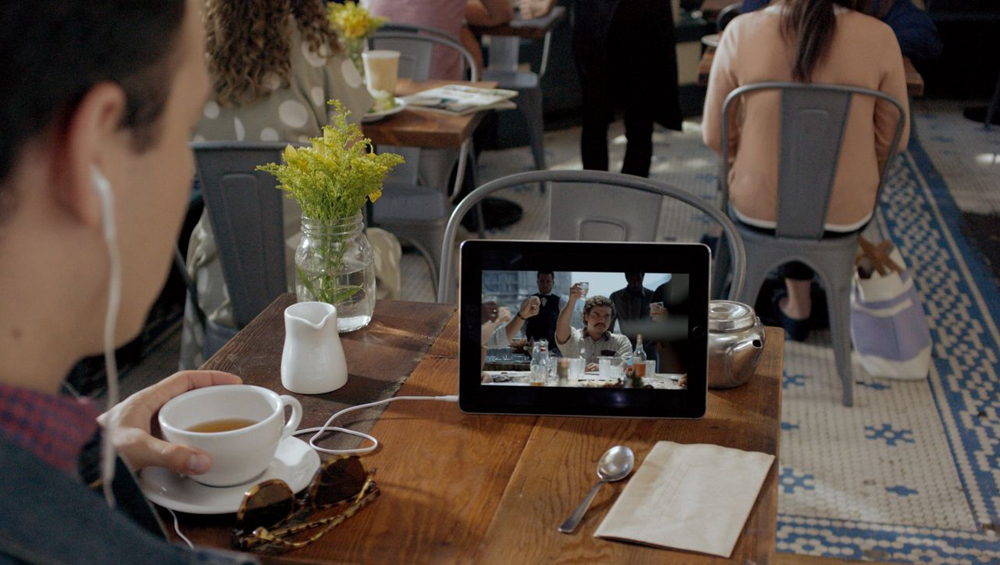
In February — typically a slower-moving month for TV consumption — total time watching TV for persons two years of age and up declined 5.1% compared to January, according to Nielsen’s The Gauge measure. Still, while other major categories fell, streaming platforms continued to pace upwards — adding 1.5 percentage points from January to a leading 34.3% share of time spent viewing — another record for the digital video format.

The Nielsen Gauge report for April 2022, published Thursday, revealed that audiences spent on average more than 30% of their total TV viewing time this past month consuming watching streaming video content. That is a record share for streaming, and up from the previous record of 29.7% that was set in March. Overall TV viewing dropped by 2.1% from March, while consumption of streaming content in April was almost identical to March, helping to increase streaming’s share of overall TV viewing by over 0.6%.

The age of streaming created weird TV habits. Which of these describes you?
Teens have long wielded soft influence over Hollywood. But today’s youth is at the center of the biggest shift in consumption habits that the video industry has seen. The post-millennial cohort known as Gen Z (anyone between the ages of approximately 8 and 22) is abandoning linear TV at faster rates than predicted even a few years ago.
Although traditional TV viewing — live and DVR use — has slipped to some extent over recent years, it is still the dominant way that viewers consume video. In the first quarter of this year, consumers 18-plus spent on average 35 hours and 26 minutes weekly with traditional TV (live and DVR), according to new research from the Video Advertising Bureau.
Mike Shields parses the conflict arising between Web video companies making claims to comparable — or larger — audiences than their television competitors, a battle that hit a new high at the recent NewFronts. He looks in particular into dubious claims by Fullscreen over its How to Survive High School web show.
Although pay TV homes are shrinking, TV viewing continues to climb. Live TV viewing rose 7% in the fourth quarter of 2015 to 1,004 hours of TV viewed per household, with time-shifted viewing -—15 days after live airing -— also gaining 7% to 356 hours of TV viewed per household, according to comScore’s TV Essentials.
Although total video consumption in 2015 was flat, consumers tuned in just a little bit more during the year’s fourth quarter. Viewing during that time was up just under 1% when you include live TV, time-shifted TV, desktop online video, DVD/Blu-Ray viewing, tablets, smartphones and multimedia/OTT devices.
Smartphones, Internet Eating Into TV Time
Nielsen data show an increase in the number of 18-to-34-year-olds who used a smartphone, tablet or TV-connected device like a streaming box or game console. That grew 26% in May compared with a year earlier, to an average of 8.5 million people per minute. Those devices, which all showed gains in usage, more than offset declines in TV, radio and computers. In the same age group, the demographic most highly coveted by advertisers, use of those devices fell 8% over the same period to a combined 16.6 million people per minute.
People are still watching as much TV as ever. They’re just watching it in different ways. That’s the finding of a new report from Pivotal Research Group, which finds that TV viewership is surprisingly stable, despite the many new options now available.
Nielsen’s second-quarter 2015 Total Audience Report shows that despite growth in digital video use, TV accounts for half of all media use for weekday and weekends between 6 a.m. and 6 p.m. TVB President Steve Lanzano says the report shows “that TV remains consumers’ medium of choice and as such, continues to be the most effective and powerful marketing medium.”
Netflix continues to have a major impact on TV viewing — its viewing hours, in relation to traditional TV viewing, are now double the number of a year ago. There were 10 billion hours streamed for Netflix against 129.5 billion hours for traditional linear TV viewing in the quarter.
A CBS survey of 700 people in the U.S. with Internet and television connections last year found that 28% said they’re watching more television than they did a year ago. Seventeen percent say they’re watching less, with the remainder indicating their habits are unchanged. That may not seem like much, but there’s a long history of people saying they are watching, or plan to watch, less TV — even as Nielsen measurements proved the opposite is true.
Good news for in-home entertainment platforms like TV: 66% of U.S. adults say they are going to the movies less often than a few years ago. At the same time, about the same percentage — roughly two-third of adults — went to movies at least once in 2013.
 Research firm eMarketer says that for the first time we are devoting more attention each day to smartphones, computers and tablets. All of which points to a big question: What counts as TV-watching today?
Research firm eMarketer says that for the first time we are devoting more attention each day to smartphones, computers and tablets. All of which points to a big question: What counts as TV-watching today?
Adults Spend More Time On Devices Than TV
 American adults this year will for the first time spend more time each day using digital media than watching TV, according to a new report by eMarketer. Adults in the U.S. are averaging five hours and nine minutes daily with digital media, up from four hours and 31 minutes last year and three hours and 50 minutes in 2011. The amount of time they spend watching TV has essentially stayed flat in that time period. It was pegged at four hours and 31 minutes this year, down slightly from four hours and 38 minutes in 2012.
American adults this year will for the first time spend more time each day using digital media than watching TV, according to a new report by eMarketer. Adults in the U.S. are averaging five hours and nine minutes daily with digital media, up from four hours and 31 minutes last year and three hours and 50 minutes in 2011. The amount of time they spend watching TV has essentially stayed flat in that time period. It was pegged at four hours and 31 minutes this year, down slightly from four hours and 38 minutes in 2012.
Younger TV Viewers Moving Offline
Growing numbers of young TV viewers have been moving offline for some time. Now, 27% of U.S. online 18-24 year olds watch five or more hours per week online. Also, 29% of those 18-24 years olds watch between one and four hours; 17% watch under one hour, and 28%, watching no video online.
Although TV primetime and other daypart viewing has been largely dominated by women viewers for years, growing gaming console use is bringing more men to the TV screen. This trend could act as a gateway to more traditional TV viewing.
Consumers Favor Watching Video Fare On TV
Despite the increasing number of options available to consumers, they’re still watching the majority of their video programming on television sets — a behavior that has some effect on consumers’ purchase considerations.
The Council for Research Excellence has issued a request for proposal for a study on how the use of mobile digital devices is affecting TV viewing behavior. Devices include tablets, smartphones and laptops.
TV Viewing Increases Cross-Platform
Even with more media choices, the average American continues to watch more TV. A new Nielsen report shows that in the April-July period, the average person watched nearly 2 hours and 45 minutes more a month than in the same period a year ago. That marked a rise of about 2% to an average of 146 hours and 20 minutes a month.
The perception that online video is cannibalizing television viewership seems to be just that: a perception. At least during prime-time hours. More than half of web series video viewers (56%) say they still tune in regularly to watch prime-time television, according to a survey of 1,500 people recently commissioned by Blip.tv, an online platform for web series.
Netflix may only have about 24 million U.S. subscribers, but 35 percent of all Americans ages 13-54 use the service at least once a month, according to a study released Thursday. The study from Knowledge Networks also revealed that each “regular user” of Netflix watches on average five TV shows and four movies per week via Netflix DVDs and streaming.
Nielsen has calculated that the storm of Jan. 10-13 was the most impactful storm in recent history. The nationwide blizzards and snowstorms didn’t just deposit record-breaking amounts of snow and ice across the country, they also deposited unusually large numbers of viewers, especially kids and teens, in front of their TV sets.
Americans watched more television than ever in 2010, according to the Nielsen Co., and the generation-long shift to cable from broadcast continued.
Marketers thought Americans spend as much time online as they do watching television, but a Forrester study released Monday confirms it. The average U.S. household watches 13 hours weekly of traditional broadcast TV, equaling the same amount of hours spent online.
DVRs Boost TV Viewing In Second Quarter
In the second quarter of 2010, U.S. television continued to reach more people over more platforms. The average person watched more than 143 hours of television per month. This rate of consumption is essentially flat compared to the same period a year ago; however, the emergence of the DVR as a widely distributed device has changed viewing behaviors in many homes.










































